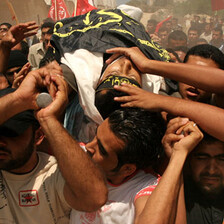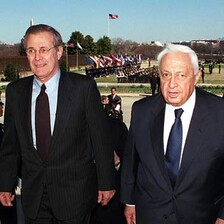The Electronic Intifada 3 June 2005
In the 1960s, there were many jokes in Israel about the “Voice of the UAR (United Arab Republic) from Cairo”, which broadcasted news in broken Hebrew, written by spokesmen of the Egyptian regime. The absurdity of these broadcasts enhanced the credibility of the IDF spokesmen in our eyes. Today, we are not all that far from the “Voice of the UAR” ourselves, and in fluent IDF Hebrew.
On 9 May, we heard that the Israeli army accidentally fired a shell into Lebanese territory. Hizbullah responded with a single Katusha shell carefully aimed at the industrial zone of the northern Israel town of Shlomi, which was deserted on the eve of Independence Day. At the end of that week (13 May), the Israeli army announced that it had been forced to shoot at Lebanese shepherds. Hizbullah claimed that the fire was directed at houses in the village of Shuba and returned fire, without casualties.
The IDF responded with tanks and aircraft, and announced that it had destroyed four positions, with casualties on the Hizbullah side. “Security sources” explained that Hizbullah was trying to provoke Israel into a confrontation, and even provided this analysis: Hizbullah was trying to consolidate its position in the approaching local elections in Lebanon. They assured us that Israel was making an effort not to get drawn into an escalation. The newspapers published and the columnists recycled this story and analysis in unison.
Only later, in the following week, did it emerge in Fishman’s column in the Yediot Aharonot Saturday Supplement that, in reality, “in Israel they decided … to test how high Hizbullah was willing to raise the flame this time.” For that reason, two of the positions that were destroyed were outside of the Har Dov sector, within which the conventions established following Israel’s withdrawal from Lebanon allow the two sides to operate. But “Hizbullah did not take the bait and contented itself with twelve shells that landed outside of the Israeli army posts, without causing damage”.[1] The Israeli army did not give up. At the end of the week it was forced once again to shoot at the anonymous shepherds, and to operate inside Lebanon. Once again the media reported only the Israeli army’s version. No analyst wondered whether it was Israel that was trying to heat up the north, and maybe even hinder Hizbullah in the elections in Lebanon.
Last Wednesday 18 May, there were several mortar attacks on Gush Katif. The “security sources”, followed by the media, explained that this was an attempt by Hamas to improve its position in the upcoming Palestinian elections, but that the Israeli army, for its part, was trying to maintain the calm. It seemed quite natural to all analysts and commentators that Hamas, like Hizbullah, believes that the way to consolidate its strengthening position, and to do well in the approaching elections, is to create a military confrontation with Israel and thus to incur the wrath of their own people, the United States of America, and the rest of the world.
No commentator bothered to mention the explanation that Hamas itself provided. A completely different version appeared in the British Guardian, for example. Hamas claims that it is responding to Israel’s constant violations of the Sharm al-Sheikh agreements. What ignited the current eruption was an incident that, in their eyes, was the Israeli army’s assassination of a Hamas activist at dawn on Wednesday — an incident that the army denies and describes as a “work accident” (that is, the man blew himself up accidentally, while preparing explosives).[2] Even if the media cannot decide between contradictory versions of a specific incident, the fact still remains that the Sharm al-Sheikh agreements determine that Israel will stop all military actions against Palestinians. None of this has been realised. The Israeli army continues to arrest, to assassinate, to enter villages and to kill even children.
The political echelon above the army, including the Prime Minister, is careful, for its part, to keep us occupied exclusively with the disengagement. On Tuesday 17 May, television news showed Sharon touring the Nitzanim area, rebuking those responsible for preparing the evacuation, and urging them to work without waiting for money or authorisation. Only at the end of the week was it casually reported in the column of Barnea and Schiffer in Yediot Ahronot Saturday Supplement, that “journalists were not invited on this tour. Instead a camera team from the government’s media office was assigned to the tour. The rebuke was nothing but a show for the camera”.[3]
The disengagement, as we know, has already been postponed from July to mid-August. When the previous date was set, the claim was that the evacuation had to be completed before the beginning of September, when the children of Gush Katif need to start school. It is likely that there are those who have begun to wonder whether the disengagement will indeed take place. The Prime Minister found it necessary to produce a propaganda reel to strengthen the faith of the dubious, and it seems completely natural to everyone that this government media film will be broadcast on television as independent news.
As with the “Voice of the UAR from Cairo”, the spokesmen of the Israeli regime write the news, the media prints and broadcasts it, and the analysts recycle it. Those who insist on knowing what is really happening must also read The Guardian and Al-Jazeera daily.
Prof. Tanya Reinhart is a lecturer in linguistics, media and cultural studies at the Tel Aviv University. She is the author of several books, including Israel/Palestine: How to End the War of 1948, from which this article was excerpted from an updated chapter. This article first appeared in Yediot Aharonot on 24 May 2005 and was translated from Hebrew by Mark Marshall.
Footnotes
1. Alex Fishman, Yediot Aharonot Saturday Supplement, 20 May 2005.
2. Agencies in Gaza, Guardian, 19 May 2005.
3. Nahun Barnea and Shimon Schiffer, Yediot Aharonot Saturday Supplement, 20 May 2005.
Related Links





